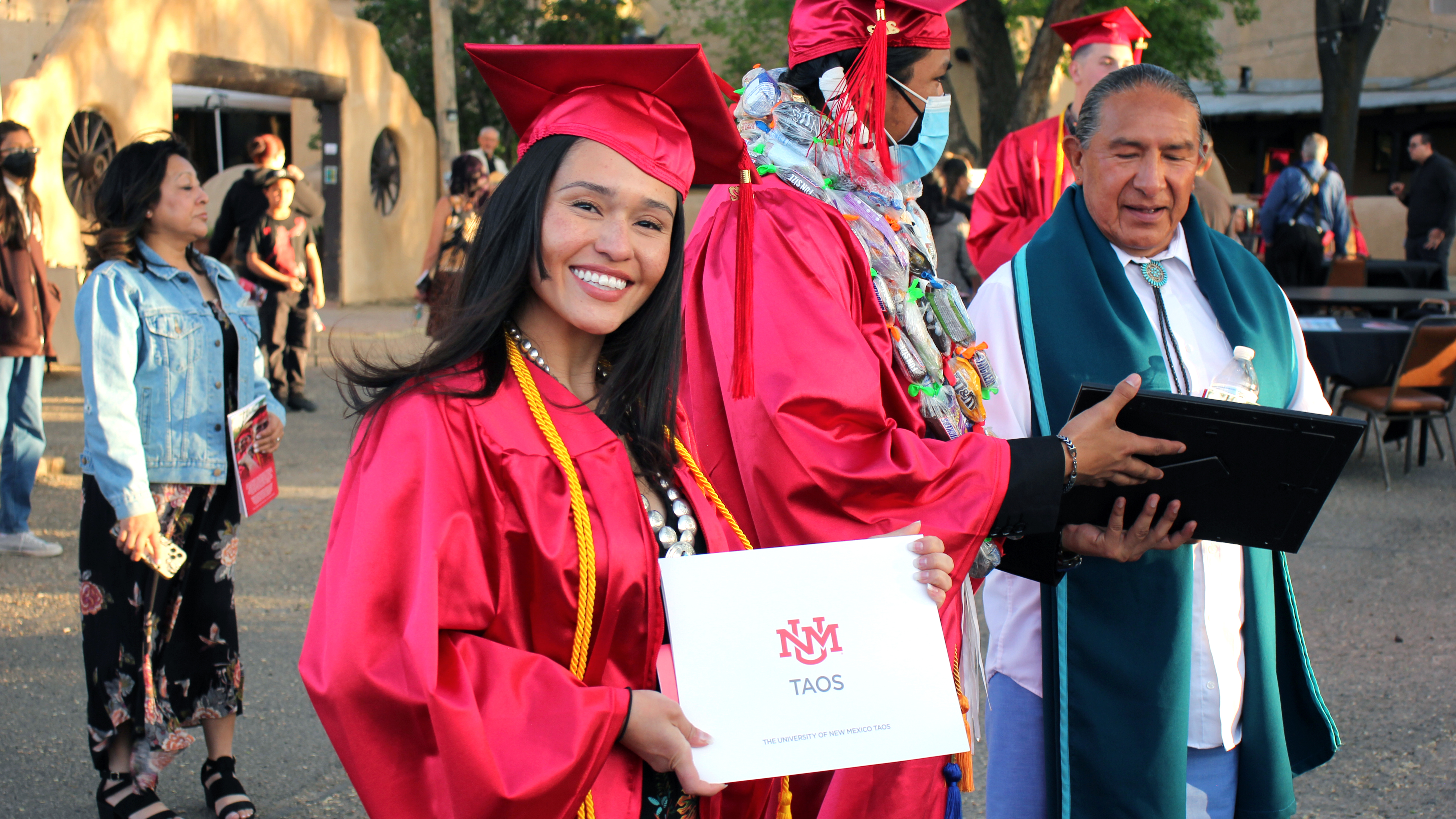Excelencia in Education features UNM-Taos in latest report
April 10, 2023

Photo by Enrico Trujillo
Being a Hispanic-Serving Institution, in part, means UNM-Taos has to have an "unyielding and unapologetic focus on ensuring the success of Hispanic, Native, and underserved students and, more importantly, equitable outcomes," said UNM-Taos Senior Institutional Researcher Alejandra Villalobos Melendez.
Due to its acceleration of and commitment to Latina/o student success, UNM-Taos is one of six colleges featured in the recently released report, Beyond an HSI Designation: Exploring Strategic Practices for HSI Grant Participation by the Latina/o-led, data-driven organization Excelencia in Education.
The purpose of an HSI (Hispanic-Serving Institution) is to grow educational opportunities for and improve the recruitment of Hispanic students; and expand and enhance the academic offerings, program quality, and stability of the U.S. colleges and universities that educate the majority of Hispanic students.
By official definition, HSIs are colleges, such as UNM-Taos, or universities where Hispanic students comprise at least 25% of the full-time equivalent student body. HSIs must be certified as such by the U.S. Department of Education. Once a school is certified, it’s given eligibility to compete for grant programs set aside for HSIs, such as Title V and Title III-Part F.
In actuality, because of Taos County’s demographics, UNM-Taos met the U.S. Department of Education’s HSI criteria before it even existed. The concept of “HSI-servingness” comes down to how and in what ways UNM-Taos serves its students, which determines their success.
“We've been working on what our identity is as an HSI,” said UNM-Taos Dean of Instruction Randi Archuleta. “Once we delved into the Caring Campus (how staff and faculty interact with students and developing strategies that help students feel at home in college) and Guided Pathways work (Guided Pathways is a structure to provide all students with clear enrollment and completion avenues, course-taking patterns, and wraparound support services), we really sat down and started talking about what does it mean to be a Hispanic Serving Institution? It means that, overall, we're serving our community. We focus efforts to improve outcomes for those who are underserved in our community and in turn, all of our students benefit from the changes that we make and the processes and systems that we improve.”
UNM-Taos Senior Institutional Researcher Alejandra Villalobos Melendez agreed that supporting students on their path to academic and professional success and upward mobility is key:
“Being an HSI means we have a critical responsibility to support our students in overcoming systems and social structures not developed with their success in mind. It means we have to have an unyielding and unapologetic focus on ensuring the success of Hispanic, Native, and underserved students and, more importantly, equitable outcomes. Also, it means we must be a student-ready institution, acknowledge and celebrate our students' cultural wealth and ensure we provide the resources and environment students need to achieve successful and equitable academic outcomes. We have the critical mission of helping our students overcome historic and systemic inequitable access to educational resources and opportunities.”
The Excelencia in Education report looked at who is involved at UNM-Taos with applying for an HSI grant; how past grants have helped create and sustain essential campus programs and faculty/staff positions; the use of funding to enhance student-centered school efforts; the use of data when applying for grants; and in what ways UNM-Taos is improving its approach to intentionally serve Latina/o students.
Making a difference in Taos
HSI funds allow UNM-Taos to continue to recruit local Hispanic students and to support them once on campus, guiding them to graduation day and setting them up for employment or to continue their education at a four-year university. All of which lead to better jobs, higher pay, and more fulfilling lives. In turn, guidance and support continually improve by addressing changes in students’ needs, thus benefiting all UNM-Taos students.
“We are making sure our teaching is culturally relevant and that we're engaging students in a culturally sensitive way, and everybody benefits from that,” Archuleta said. “We know the cultural streams that are part of what make Taos such a vibrant community.”
Data collected by Villalobos Melendez informs what UNM-Taos does regarding courses offered, how they are taught, and academic/nonacademic support. Becoming a data-informed and evidence-based college is an ongoing process, but UNM-Taos strongly focuses on ensuring that its activities, processes, and goals are responsibly informed.
“For example,” she said, “the Caminos a la Cumbre (Guided Pathways) and Caring Campus are excellent examples of research/evidence-based priorities. Developing Guided Pathways at UNM-Taos has been directly supported by HSI grants.”
HSI grant impact at UNM-Taos
The Developing Hispanic-Serving Institutions (DHSI) Program – Title V: This program provides grants to assist HSIs to expand educational opportunities for, and improve the attainment of, Hispanic students. These federal grants also enable HSIs to expand and enhance their academic offerings, program quality, and institutional stability in ways such as scientific or laboratory equipment for teaching; construction or renovation of instructional facilities; professional development; purchase of educational materials; and academic tutoring or counseling programs; and student engagement techniques for faculty.
Additionally, Title V grants have been instrumental in growing the institutional research capacity at UNM-Taos, which is the ability to define problems, set objectives and priorities, conduct sound scientific research, build sustainable institutions, and identify solutions to key problems. This growth in research has made it possible to give more data and information to administrators, faculty, and staff to develop a deeper understanding of the student population and their needs, and to increase the timeliness of outreach and services. UNM-Taos has also identified key performance indicators to guide further analysis to identify insights and track the school’s progress.
“To offer an example,” said Villalobos Melendez, “analysis of our institutional data has informed the instructional modality (provides critical information to students by setting expectations for their learning experiences) of courses offered. This was critical in navigating the pandemic and return to campus.”
A couple of pre-pandemic Title V grants had the main purpose of addressing distance education. “It was cool because we had two grants that really beefed up our ability to provide remote education,” Archuleta said. “So, when that transition happened during COVID, we were in good shape. We'd already been working so hard on providing quality distance education that I think, in some ways, we were ready. Those two grants had a huge focus on dual credit and teacher education, Guided Pathways, and mathematics. So, we were bulked up.”
Because of Title V grants, UNM-Taos student support services are wider and broader than ever, thus increasing students’ chances of earning a certificate or an associate degree. Examples of wraparound services include — but aren’t limited to — tutoring, crisis care and outreach, food insecurity, and transportation. A Title V grant allowed UNM-Taos to hire a student resources navigator who coordinates a wide range of resources, assists students in evaluating and addressing their specific barriers, and ensures they are aware of all the available opportunities and benefits.
“To say Title V grants have been transformational cannot be overstated. They are indispensable for the institution and our students,” Villalobos Melendez said.
Additionally, Title III-Part F: The Strengthening Institutions Program (SIP) provides federal funding to support colleges to help them become self-sufficient and expand their capacity to serve low-income students by providing funds to improve and strengthen the institution's academic quality, institutional management, and fiscal stability.
Title III-Part F funds may be used for a variety of purposes including planning, faculty development, and establishing endowment funds. Administrative management and the development and improvement of academic programs also are supported. Other projects include joint use of instructional facilities, construction and maintenance, and student service programs designed to improve academic success. The latter includes innovative and customized instruction courses designed to help keep students in school and move them more quickly into core courses and through program completion, which may involve remedial education and English language instruction.
“STEM X is our first time holding a Title III-Part F without partnering with another college.” Archuleta said. “This grant focuses on all the STEM disciplines (science, technology, engineering, and mathematics); tying those in through K-12 education and how to build a STEM-going culture in the community to have more people flow through the STEM fields.”
All in all, developing Guided Pathways at UNM-Taos has been directly supported by these grants. To date, these HSI grants have been a major force of change for academic advising, providing student support services, faculty hiring and creating a faculty culture and offering more courses to students. Archuleta said the math department has been “revolutionized” by Title V grants, and academic advising and tutoring have also been, in particular, positively impacted.
“These grants are game-changers,” said Archuleta. “This community college is where we make a difference. This is where we impact lives and HSI funds help us do that. You can carry the title of being an HSI, but if you don't think about it and what it means and the serving aspect of it, then it doesn't have the same meaning.”
View the Excelencia in Education report here: https://tinyurl.com/hsipublication
